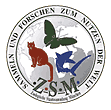Difference between revisions of "About the DNA Bank Network"
| Line 8: | Line 8: | ||
The DNA Bank Network aims to establish a technically optimized DNA collection service facility for all biological research. DNA samples of on-site research and of selected natural history collections of the institutes will be incorporated. Also, the network promotes deposition of well documented DNA samples after project completion or data publication from scientists of other universities and institutions. In addition to DNA storage, scientists will be given the opportunity to store tissue material. In this way, material remaining from previous studies can be made available to other researchers. | The DNA Bank Network aims to establish a technically optimized DNA collection service facility for all biological research. DNA samples of on-site research and of selected natural history collections of the institutes will be incorporated. Also, the network promotes deposition of well documented DNA samples after project completion or data publication from scientists of other universities and institutions. In addition to DNA storage, scientists will be given the opportunity to store tissue material. In this way, material remaining from previous studies can be made available to other researchers. | ||
| − | [http://www. | + | [http://www.google.de [[File:Zsmlog3.gif]]] |
| + | |||
[[Category:Webportal]] | [[Category:Webportal]] | ||
Revision as of 11:24, 21 July 2011
The DNA Bank Network was established in spring 2007 and is currently funded by the German Research Foundation (DFG). The network was initiated by GBIF Germany (Global Biodiversity Information Facility). It offers a worldwide unique concept. DNA bank databases of all partners are linked and are accessible via a central web portal, providing DNA samples of complementary collections (microorganisms, protists, plants, algae, fungi and animals).
The Botanic Garden and Botanical Museum Berlin-Dahlem (BGBM) is coordinating the network, here the databases and Web portals are being designed, and botanic DNA samples (plants, algae, protists) are being stored. The DNA bank of the Bavarian State Collection of Zoology Munich (ZSM) focuses on safeguarding DNA of invertebrates (I), lower deuterostomes and fungi. The Forschungsmuseum Alexander Koenig Bonn (ZFMK) covers all additional invertebrate groups (invertebrates II) and vertebrates. The German Collection of Microorganisms and Cell Cultures Braunschweig (DSMZ) is specialized on DNA storage of micro-organisms, cell lines, and plant viruses.
The DNA bank of the New York Botanical Garden (NYBG) has joined the DNA Bank Network on February 23th 2011 as its first international partner.
The DNA Bank Network aims to establish a technically optimized DNA collection service facility for all biological research. DNA samples of on-site research and of selected natural history collections of the institutes will be incorporated. Also, the network promotes deposition of well documented DNA samples after project completion or data publication from scientists of other universities and institutions. In addition to DNA storage, scientists will be given the opportunity to store tissue material. In this way, material remaining from previous studies can be made available to other researchers.
